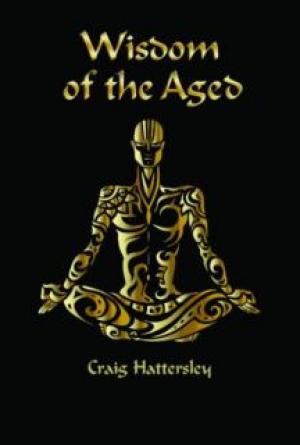pointe, ethereal and among the blessed.
Throughout, Miss Graham’s movement is unfailingly precise. It goes at
once straight to the muscles and to the mind, and it’s this that helps make
her work so special; its appeal to the body equals its appeal to the intellect,
and both are of a high order indeed.
167
A Beautiful Time for Dancers
Diversion of Angels is a plotless work and wonderfully exciting in the rich invention of its gestures. Dramatically it’s luminous, making marvelously
convivial use of the ensemble. The disposition of its cast of 11 is never ex-
pected; it always looks fresh and new.
Central to the piece is the contrast between the girl in red (Takako
Asakawa) and the one in white (Janet Eilber). Their colors imply their quali-
ties; the former moves with brilliant impulse, the latter is long-lined and
lyrical, altogether more innocent. Complementing them are the gestures of
the group, which include some striking movements, such as cartwheels and
an elegant low-slung sweep of the arm, which looks like a bowler’s gesture.
Though Miss Graham no longer dances, she has trained a company that
performs with great authority. Misses Asakawa and Eilber were outstand-
ing in Diversion of Angels, as were Ross Parkes and Tim Wengerd; Seraphic Dialogue seemed a bit wooden, but was touching nonetheless.
A couple of caveats: the music was taped and the sound system indif-
ferent. Without live music there’s a tendency for dancers to move slightly
behind the beat. More generally, I regret the absence of Bertram Ross, the
strongest personality among Miss Graham’s men, and an irreplaceable Saint
Michael.
But see the company by all means. It’s giving us an invaluable opportu-
nity to see some of the century’s great dances.
November 2, 1973
W
Martha Graham, Still Potent Force
new york — Several seasons after Martha Graham made her New York
debut in 1928, the much-missed magazine Modern Music offered the follow-
ing appraisal by composer Marc Blitzstein:
Martha Graham is the one to get excited about. . . . Graham is
fanatical, which is good; definitely committed to a type by her
macabre and mystical face, and by her spirit which is narrow and
deep. She goes deeply into mysticism with an intensity at once fero-
cious and brooding. She seldom forsakes this note; it becomes a
marvelous inhumanity (not a non-human inhumanity, but a genius
inhumanity).
168
Pushing Boundaries
This was sophisticated observation and savvy prophecy. More than
40 years later, Miss Graham’s power is undiminished. Last night she and
her company opened at the Mark Hellinger Theater with a program of ex-
cerpts from the Graham heritage that was brilliant in both conception and
execution.
Each of Miss Graham’s appearances is a major event, and last night the
dance world again paid her tribute. The audience included Rudolf Nureyev,
Jerome Robbins, and Tanaquil Le Clercq, as well as Oliver Smith and Lucia
Chase, directors of the American Ballet Theatre.
Miss Graham opened the show with an autobiographical exposition of
her art: “To me, theater was a verb before it was a noun; it was an act before
it was a building . . . the body is a lovely garment . . . freedom to dance
means only one thing to a dancer—discipline.” And referring to her own
retirement from a life of active performance, she continued: “Time has that
curious way of saying this far and no further.”
Well, perhaps. But Miss Graham is still a potent force. Her program
last night was spotty and uneven—did such a knowing first-night audience
really need a demonstration of technique? Yet the choreography itself came
across with great force.
We saw scenes from Clytemnestra, Appalachian Spring, Cave of the Heart, Deaths and Entrances, and Diversion of Angels. Seen as excerpts, the works can’t be judged as a whole. Still, there were wonderful performances by Pearl
Lang in Clytemnestra; Phyllis Gutelius, William Carter, and David Hatch
Walker in Appalachian Spring; and Ross Parks, Yuriko Kimura, and Takako
Asakawa in Cave of the Heart.
On the whole then, the program was perhaps inconclusive. We can only
be sure that Miss Graham’s works are still magnificently powerful instru-
ments for evoking from her audience an intimate and revealing response.
April 16, 1974
169
A Beautiful Time for Dancers
W
The Art of Graham as Autobiography
Today more than ever, at the end of her career, it’s clear that Martha Gra-
ham stands at the very center of American modern dance.
Historically, she’s the link between the tentative experiments at the
start of the century and the most distinguished work of today—between
Denishawn at one end and Cunningham and Taylor at the other.
Letter to the World, which was premiered in 1940 and performed by Miss
Graham’s dancers on Friday and Saturday nights in Lisner Auditorium, is a
formidable statement about the artist at midcareer. You can’t see the piece
without realizing how closely it touches both her personal and professional
lives, as well as her fight for aesthetic existence and emotional tranquility.
Outwardly, the work is a portrait of Emily Dickinson. A speaker
choreographed into its fabric gives a running recitation, and the action,
led by the speaker’s alter ego, takes place in a dream world of reflection,
remembrance, and dread.
Though the events of the narrative are easy to follow, the piece as a
whole seems difficult. This comes, I think, from its differences with most
other works of its time. It’s enormously long, for instance, a full 58 min-
utes, and its dramatic structure is not sequential; linear time cedes to free
association. It uses the stage in a strange way, too, not as a self-enclosed
arena, but rather as a slice of a realistic setting. The people we see have lives
apart, and our meeting them seems almost incidental.
Yet these innovations make for a tough and challenging work. It has
some splendid pieces of dance, foremost among them the extraordinary
whimsical “Little Tippler,” the airborne role for “Dear March,” and the solo
made by Miss Graham for herself during “Leaf at Love Turned Back.”
The company gives Letter a fine performance. Pearl Lang moves beauti-
fully in Miss Graham’s role and strongly resembles her mentor. As the One
Who Speaks, Jean Erdman is matchless in a role she created; William Carter
has the right poetic sensibility for the Lover; and David Hatch Walker is ath-
letic enough in Merce Cunningham’s old role of “March,” though I think he
could be more elfin.
November 5, 1973
170
Pushing Boundaries
W
Impact Undimmed: Martha Graham at 80
new york — Few things in dance have ever so thrilled me as the five
performances of the Martha Graham Dance Company that I witnessed last
weekend. Nothing had prepared me for the impact of her dance; not films
of the works, not the literature, not the often eloquent body of visual docu-
mentary that her pieces have inspired.
The programs I saw, which concluded her company’s two-week sea-
son at the Alvin Theatre, offered a survey of her career over 33 years; the
earliest piece seen was El Penitente from 1940, and the most recent works
were two premieres, Mendicants of Evening and Myth of a Voyage. Between them came, among other works, Appalachian Spring (1944), Diversion of Angels (1948), Seraphic Dialogue (1951), and Clytemnestr a (1958).
What a magnificent body of works in this tip of the iceberg of Miss
Graham’s complete oeuvre. It must have been marvelously exciting to have
lived through the period of ferment when these great creations were born.
Yet we’re in a privileged position to see them today. The atmosphere around
them is more dispassionate. They’re no longer objects of controversy but
objects of delight, and this is because of the all-pervasive influence Miss
Graham has had for almost half a century in all the arts, and most specifi-
cally in dance.
No choreographer could avoid her, and the list of those who worked
with her and learned from her bears witness to her brilliance: Paul Taylor,
Merce Cunningham, Erick Hawkins—these are an obvious few.
Yet no one has excelled Miss Graham in the visceral power of her dance
or the intellectual excitement it provides. Her movements go straight to your
muscles and elicit an uncanny sympathy, partly because the sources of her
imagery are found deep in pictorial traditions we’ve long absorbed, partly
because her understanding of bodily rhythms is so subtle and convincing.
There are characteristic elements to her style, and underlying them all
is the fundamental juxtaposition of tension and release. You can see this
written small in the abdominal contractions and relaxations that telegraph
a feeling of stricken, inner pain, or written large in the balances on one foot
(a motif of Diversion of Angels), where the body pendulates from side to side, pushing itself to the limits of equilibrium before rebounding.
171
A Beautiful Time for Dancers
Miss Graham can be astonishingly bold in her use of space. In Clytemnestra, for instance, she applies great swaths of movement across the stage as a
painter would apply oil on canvas. When less adventuresome, she’s no less
discerning: in El Penitente, a street-theater reenactment of a passion play based on the rites of a Southwestern sect, the three players processionally
enter the stage as if it were a village square and demarcate the area on which
they’ll perform.
In 1947 the distinguished critic Edwin Denby wrote of her works, “There
is rarely a perceptible rhythmic unit or any dance architecture.” Perhaps
not as in Balanchine’s choreography—which was Denby’s touchstone—
where the regular patterns of classical music determine the articulation of
the dance. But in a deeper sense, Miss Graham’s works have a pulse and
spatial boldness that grow from within the body and fulfill more profound
demands.
It’s fascinating to see how she adapts historical details to her technique.
Seraphic Dialogue, for example, is a celebration of Saint Joan at the moment of her exaltation. It’s constructed in a series of flashbacks; at the feet of
Saints Michael, Catherine, and Margaret, Joan examines her past roles as
Maid, Warrior, and Martyr.
The imagery of the dance is drawn from the iconography of early
renaissance painting. Its gestures could be out of Giotto—the hands of
Catherine and Margaret as they speak, arched in an ogive before them,
with wrists touching and hands bent back, or the deploratory grimace and
tilt of Michael’s head and the palms-forward poses of his hands held before
him. The renaissance is also referred to by Isamu Noguchi’s stunning set, a
triangular altar of geometric complexity that reaches for the sky, fashioned
out of gleaming tubular steel.
Yet there’s nothing antique about the animation of the dance. It has
great propulsion, despite its segmented structure, and the solos for the
three Joans are full of enormous and ceaseless invention.
Clytemnestra is Miss Graham’s most ambitious work theatrically and
easily her most complex. The House of Atreus is opened at several levels:
the prologue and epilogue occur in the Underworld, and the two acts
between, on Earth, which we reach through flashbacks that Clytemnestra
generates in memory’s torment. Further complications are created by the
multiple casting of Agamemnon.
172
Pushing Boundaries
It’s a serious challenge that Miss Graham gives us, worthy of complete
participation. Clytemnestra is an epic work and wonderfully rewarding, for dramatically the story is relentlessly intense. It slackens somewhat at the
end, with weak and watery dances for Apollo and Athena, but this is a
minor flaw.
Of the pair of premieres, Mendicants of Evening seems at first sight the
more successful: it’s an awesome and imposing work. There are three
principal roles—The Witness, The Guide, and The Poet—and as verses of
Saint-John Perse are read by The Witness, four duets and a dance for five
unfold.
The momentum of the work is slow; it has great dignity and restraint.
It’s perfectly in tune with the texts by Perse, which place mankind at the still
point in the center of a turbulent cosmos. I speak in confusion of Mendicants, for one viewing isn’t enough to absorb its riches. But I was touched by the
piece and hope soon to see it again.
The performances were excellently danced. Bertram Ross, a stalwart
of Miss Graham’s company, has remarkable authority and presence and the
most beautiful hands imaginable, which are at their most poetic in Seraphic
Dialogue, where Ross plays Saint Michael.
Pearl Lang and Mary Hinkson shared Miss Graham’s roles—this is the
first season her company has given during which she didn’t perform—and
though both move beautifully, neither woman fills her readings with the
completeness or complexity Miss Graham brings to them.
May I make a suggestion? No American artist is more deserving of the
nation’s highest recognition—the Presidential Medal of Freedom. Since
her first New York concert in 1926, Martha Graham has worked a lasting
influence on all the arts in America: on theater (Bette Davis, Joanne
Woodward, and Eli Wallach are among her students); on music (she has
worked with Aaron Copland, William Schuman, and Wallingford Riegger,
among many, many others); on the visual arts (Noguchi and Alexander
Calder are her two most prominent collaborators); and, of course, on
dance, where we’re all in her debt.
Past recipients of the medal include Rudolf Serkin, Eugene Ormandy,
and Duke Ellington. At the age of 80, Miss Graham is the most vigorous
and stimulating of her peers and supremely deserving of the country’s
thanks and tribute.
May 20, 1973
173
A Beautiful Time for Dancers
W
Graham’s Shift Put in Focus
The critical era in Martha Graham’s career was the decade of the 1940s.
During that time, she shifted her interests from the legend and lore of
America to the more personal work of the mythical Greeks and to an in-
nocent abstraction.
In its program presented on Friday and Saturday nights in Lisner Au-
ditorium, the Martha Graham Dance Company, perhaps unintentionally,
focused our attention on this striking change of emphasis. Appalachian Spring
(1944), which opened the evening, is Graham’s most ambitious work con-
cerned with our native past; Dark Meadow (1946), which closed it, is a work rich in myth that marked the start of the stage of transition; and Diversion of Angels (1948), which was sandwiched between them, shows a side of Miss
Graham that is serene and mature.
Of all her works in the American mode, none is more musically telling
than Appalachian Spring. Aaron Copland’s score is far more substantial than the merely tuneful for which Graham usually settled; it is melodically solid
and stands on its own. Paradoxically, it seems to have constricted Graham’s
creativity and to have not inspired her. Its strains, one suspects, were per-
ceived as a threat, not accepted and embraced as a challenge. Graham’s Ap-
palachian is a pleasant piece, but its imagery is conventional, its narrative pat.
There are few of the striking touches that make her other works so singular.
Such touches as I have in mind are seen in Diversion of Angels. One of
them, a motif of the piece, is the pendulating sequence of balances in which
the dancers rock their weight and bulk from side to side. Another is the
gesture at the start of the piece that looks like a bowler releasing his ball.
This and other movements are suggestive of an athletic tension, and their
sympathetic use with the music is theatrically apt and touching.
The performances I saw of these works were largely lacking luster. On
its welcome annual visit, the Graham Company looked tired. Ensembles
were marred by imprecision, slight but telling nonetheless, and solo work
was too often slack. A notable exception was Janet Eilber’s performance of
Lamentation, which I saw Friday night.
April 14, 1975
174
Pushing Boundaries
W
Graham Impact on Stage
Here’s a bit more on the Martha Graham Dance Company, which Sunday
night ended its series in Lisner Auditorium.
Miss Graham has had a pervasive influence on contemporary theater,
and not just in matters of movement. Her use of costumes and decor, for
instance, has been style-setting. She collaborated most memorably with
two of the finest talents of the time—the sculptor Isamu Noguchi and the
designer Arch Lauterer—and examples of their brilliant work were seen
this weekend.
For instance, in Cave of the Heart, designed by Noguchi, the most strik-
ing prop onstage is a spindly silver object a dancer can crawl into and wear
like a coat. It is part artifact and part costume, suggestive of a tree and
decorative as such.
But when Medea, whose legend is told by the piece, enmeshes herself in
its spidery arms and hovers menacingly over Jason and Glauce, we realize its
true nature—a symbolic representation of the fire with which the vengeful
Medea cursed the lover of her unfaithful husband. The sculpture, in fact, is
luminously ablaze, and its branches dart like tongues of flame.
Equally inventive and versatile is a white painted piece of furniture for
Letter to the World that Arch Lauterer designed after Miss Graham’s sug-
gestion. It is hard to define precisely, because it keeps changing from
settee to rocker to table. On a deeper level, it stands for the domestic as-
sociations that run through the script of Miss Graham’s homage to Emily
Dickinson. It’s an anchor for homebodies and far richer in meaning than its
surface forms suggest.
Also seen this weekend were Appalachian Spring and El Penitente, each of which reflects different facets of Miss Graham’s productive obsession with
Americana.
The 1940 Penitente is a picture of a Southwestern sect of flagellants
as they perform a passion play in a village square. Appalachian Spring,
which ended the Americana phase in 1944, tells of “the pioneering woman”
about to be married and ready to tame the wilderness. It’s the story,
of course, of Miss Graham—the Dickinson piece reflects her, too—and it
175
A Beautiful Time for Dancers
is as touching for the honesty of its personal statement as it is for the imag-
ination of its dance.
Despite the regrettable loss of two of its finest dancers—Mary Hinkson
and Bertram Ross—the company performed well all weekend. (One has
reservations, to be sure, but these have to do with the impossibility of reliv-
ing the past; nobody will ever dance the central role in Letter with the lyrical strength of Miss Graham, nor will anybody have her malevolent electricity
in Cave or her tenderness in Appalachian Spring.)
Especially impressive were Ross Parker, who is smaller in stature than
Bertram Ross but shares his authoritative demeanor, and Takako Asakawa,
who has personal magnetism and quicksilver speed. They and their col-
leagues keep alive a repertory of unequaled intelligence and innumerable
beauties, the legacy Miss Graham has left us.
November 6, 1973
W
A Dance Goddess and Her Disciples
Mark Ryder, who has headed the Dance Department at the University of
Maryland since the start of this semester, is a man with a fascinating past.
He came to College Park with his wife, Ann, and their three daughters
from the experimental Goddard College in Vermont, where he ran the
dance program for the previous eight years. A while earlier, he was direc-
tor, with Emily Frankel, of the Dance Drama Company, the first repertory
troupe devoted wholly to modern dance, which was an offshoot of their
Dance Drama Duo. And before that, he spent eight years as a leading dancer
with Martha Graham.
Miss Graham found Ryder in 1941 at the Neighborhood Playhouse on
New York’s Lower East Side, where he had studied since childhood and
where she had taught since moving to Manhattan in the late 1920s. He first
was invited to join the company for the New York premiere of Letter to the
World, and he subsequently danced major roles in Appalachian Spring, Diversion of Angels, Night Journey, and Errand into the Maze, among other Graham creations.
It was an intriguing time to work with her. As an artist, Graham’s scope
was widening both theatrically and thematically: she was in flux, and her
company swayed in her wake. It was also a time of strong personalities.
176
Pushing Boundaries
Merce Cunningham, Erick Hawkins, and Paul Taylor, all of whom since
have found artistic independence as dancer-choreographers, were still Gra-
ham disciples, and Louis Horst, her music director and a teacher of genius,
was still deeply enmeshed in her career.
Ryder recalls the time vividly. “I saw the company going through several
changes. Men had been added relatively recently, in 1938 for American Docu-
ment, and the first one was Erick Hawkins. Erick had tremendous problems
that no one could overcome. He was a ballet dancer in a group that had a tra-
ditional anti-balletic framework; he was a male in a company that had been
all female; he was replacing Louis Horst emotionally and physically with
Graham when Louis was a demi-God next to the Goddess. How could you
function against that? When I got there, they still resented him quite hard.”
More generally, Ryder notes, the look of the ensemble was about to be
altered. “The women when I got there were Amazon-like; you’d see large
earthy bodies. I was drafted and went away to the Army, and when I came
back, the following dancers had been added: Yuriko, Ethel Winter, Helen
McGehee, all light and small. The character of the company was changing.
“This had a great deal to do with the change in Graham’s themes. Every
Soul Is a Circus, for instance, which featured Erick and Merce, made a tremendous use of light, prancy, jumpy material on the part of the group. But
the heavier girls who could do Primitive Mysteries like crazy weren’t able to work with that; there’s a certain quickness that the larger women couldn’t
encompass, and Graham found herself needing smaller ones.”
This was the physical type that best could project Miss Graham’s ideas,
according to Ryder’s h







